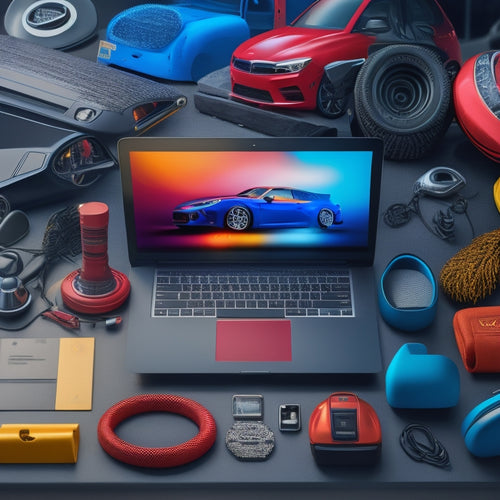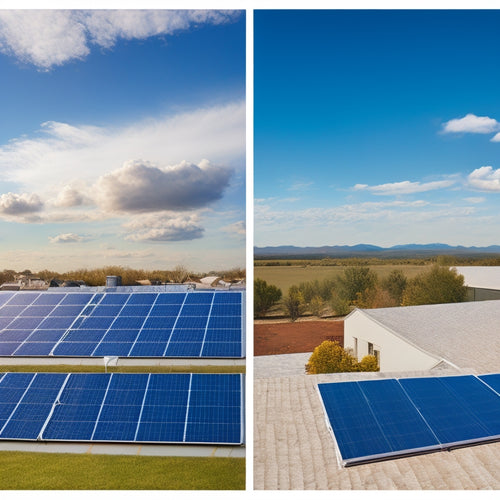
Cleaner Cities Through Vehicle Electrification Solutions
Share
As you consider cleaner cities, you're likely exploring vehicle electrification solutions. By adopting electric vehicles, you'll greatly reduce emissions and pollutants, creating a healthier environment for citizens. Cleaner air, improved respiratory health, and reduced noise pollution are just a few benefits. Electrifying public transportation systems and incentivizing EV ownership locally can also expedite progress. Strategically planning infrastructure, including advanced charging corridors and urban hubs, is vital. Now that you've started on this journey, you're one step closer to tapping into the full potential of cleaner cities – and there's more to discover about how to get there.
Key Takeaways
• Widespread adoption of electric vehicles reduces air pollutants, improving urban air quality and promoting healthier environments.
• Strategic investment in advanced charging infrastructure enables efficient energy systems and supports growing EV demand.
• Electrifying public transportation systems decreases emissions, inspires sustainable infrastructure, and sets a global example for environmentally friendly practices.
• Local governments can incentivize EV ownership through targeted rebates, tax credits, and exemptions, alleviating upfront costs and range anxiety.
• Transitioning to electric vehicles diminishes negative environmental impacts, reduces noise pollution, and supports sustainable urban ecosystems.
Reducing Emissions Through EV Adoption
As the world shifts towards a more sustainable future, you're likely to find electric vehicles (EVs) playing an increasingly prominent role in reducing emissions. As you consider making the switch to an EV, you might wonder how this shift will impact the grid.
The truth is, widespread EV adoption can lead to grid saturation, where the increased demand for electricity strains the existing infrastructure. However, this challenge also presents an opportunity. By investing in advanced charging infrastructure, you can guarantee a seamless shift to an electrified transportation system.
This infrastructure includes high-power charging corridors along highways, as well as urban charging hubs that can accommodate multiple vehicles at once. By planning strategically, you can mitigate the risk of grid saturation and create a more resilient, efficient energy system.
As you join the EV revolution, you're not only reducing your carbon footprint but also contributing to a more sustainable energy future.
Cleaner Air for Urban Residents
By switching to electric vehicles, you'll be contributing to a significant reduction in air pollutants, which disproportionately affect urban residents who already suffer from poor air quality.
As you drive through city streets, you'll be producing zero tailpipe emissions, reducing the amount of particulate matter, nitrogen oxides, and volatile organic compounds that harm human health. This is especially vital in urban areas, where air quality is often compromised by high population density and concentrated traffic.
Effective urban planning can amplify the benefits of electric vehicles, by optimizing traffic flow and reducing congestion. By designing cities with electric vehicles in mind, urban planners can create more efficient, sustainable, and healthier environments for residents.
With cleaner air, you'll be breathing easier, and so will your community. By choosing electric, you're not only reducing emissions but also improving air quality, making your city a better place to live.
Electrifying Public Transportation Systems
Your decision to electrify public transportation systems won't only reduce emissions from buses and trains but also create a ripple effect, inspiring a broader shift to sustainable transportation infrastructure.
By shifting to electric vehicles, you'll greatly decrease pollutants and greenhouse gas emissions, resulting in cleaner air and a healthier environment for urban residents. To achieve this, an infrastructure upgrade is vital. This includes installing charging stations and upgrading electrical grids to support the increased demand.
Effective fleet management is also essential, as it guarantees the efficient allocation of resources, reduces costs, and optimizes routes. By implementing smart charging systems, you can further minimize strain on the grid and reduce operating expenses.
As you electrify public transportation systems, you'll not only improve air quality but also create a model for sustainable transportation that can be replicated across the globe.
Incentivizing EV Ownership Locally
To drive widespread adoption of electric vehicles, local governments and businesses must collaborate to create targeted incentives that alleviate the upfront costs and range anxiety associated with EV ownership.
As you consider making the switch to an electric vehicle, you'll want to explore local incentives that can offset the higher purchase price. Many municipalities offer rebates, tax credits, or exemptions that can greatly reduce the cost of EV ownership. For instance, you might be eligible for a rebate on the purchase of a new EV or a credit towards the installation of a home charging station.
Municipal partnerships with local businesses can also provide additional perks, such as preferred parking spots or discounts on charging services. By taking advantage of these local incentives, you can enjoy the environmental benefits of EV ownership while also saving money.
A Healthier Environment for Citizens
One notable advantage of widespread EV adoption is that it can greatly diminish the negative impact of transportation on local air quality, resulting in a healthier environment for citizens.
As you go about your daily life, you'll notice a significant reduction in air pollution, which translates to improved respiratory health and a decrease in related illnesses. This is particularly vital in urban areas, where population density and traffic congestion often lead to poor air quality.
By incorporating green spaces into urban planning, cities can further mitigate the effects of pollution and create a more livable environment. With EVs, you'll have a chance to breathe easier, enjoying cleaner air and a reduced risk of respiratory problems.
Furthermore, as cities shift to electric transportation, you'll witness a decrease in noise pollution, making your daily commute more peaceful. By embracing vehicle electrification, you'll be contributing to a healthier, more sustainable urban ecosystem.
Frequently Asked Questions
How Do Electric Vehicles Reduce Greenhouse Gas Emissions Globally?
As you wonder how electric vehicles reduce greenhouse gas emissions globally, consider this: by leveraging carbon offset and boasting superior fuel efficiency, EVs slash emissions, making them a game-changer in the quest to curb climate change.
Can Electric Vehicles Be Powered by Renewable Energy Sources?
You can power electric vehicles with renewable energy sources, leveraging energy harvesting from solar or wind farms to fuel your ride, while enhancing grid resilience through smart charging systems that stabilize the power grid.
Are Electric Vehicle Batteries Recyclable at the End of Their Life?
You're wondering if electric vehicle batteries are recyclable at the end of their life. Yes, they are! Battery recycling is possible through closed-loop systems, where old batteries are collected, processed, and reused to manufacture new ones, minimizing waste.
How Do Governments Plan to Handle Increased Electricity Demand?
As you plug into the grid, it's like pouring water into a leaky bucket - will it hold? Governments plan to manage increased electricity demand by investing in grid expansion, infrastructure upgrades, smart meters, and rate adjustments to guarantee a seamless flow.
Will Electric Vehicles Increase the Strain on the Power Grid?
As you consider the impact of electric vehicles, you'll wonder if they'll strain the power grid. Fortunately, utilities are upgrading grid capacity and investing in energy storage solutions to guarantee a smooth shift.
Related Posts
-

Top 10 Tips for Buying Car Accessories Online
When purchasing car accessories online, you should take proactive steps to avoid low-quality or incompatible products...
-

Tracking Solar Panels Vs Fixed Panels Cost Savings
When considering solar panel options, you'll want to weigh the cost savings of tracking solar panels versus fixed pan...
-

Best Solar Panel Options for Maximum Energy Savings
You can maximize your energy savings with solar panels that boast efficiency ratings above 20%, paired with extensive...


